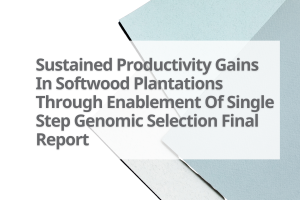Purpose
The project aimed to improve eucalypt breeding by introducing single-step genomic selection. Researchers created new genetic datasets and developed methods for accurate selection. This approach increased breeding efficiency and enhanced the quality of planting material.
Summary
The project advanced single-step genomic selection in Australian eucalypt breeding programmes. Researchers built foundational datasets and developed methods for both Eucalyptus nitens and Eucalyptus globulus. They generated new genotype and sequence data, which captured most genetic variation in these breeding populations. The team designed and tested pipelines for imputation and pedigree recovery, applying them to operational breeding. In 2021, they combined new and existing data in TREEPLAN analyses, achieving joint use of datasets from different technologies. This implementation improved the accuracy of estimated breeding values (EBVs) and enabled earlier selection of unmeasured germplasm. As a result, breeding became more efficient, and the industry gained access to better planting material, boosting productivity and resilience. The project also developed pedigree forensics tools and recommended further expansion of genomic resources and training sets to maximise future genetic gains.
Benefits to the Forest and Wood Products Industry
This research offers several benefits to the industry:
- The project increased the accuracy of breeding value predictions, leading to better tree selection.
- It improved breeding efficiency, allowing faster delivery of high-quality planting material.
- The industry gains more productive, resilient, and profitable eucalypt plantations
Acknowledgement
This work was supported by funding provided to Forest and Wood Products Australia (FWPA) to administer the National Institute for Forest Products Innovation program (NIFPI).
Funding for the program was provided by the Australian Government, the Tasmanian Government and Australian forest and wood products industry.



